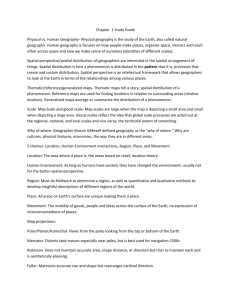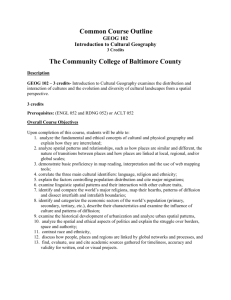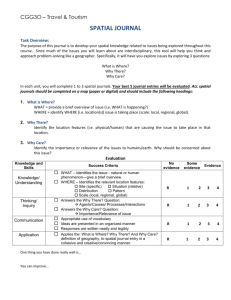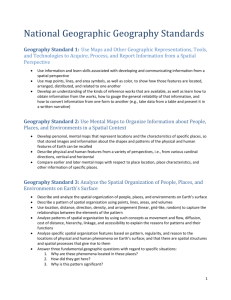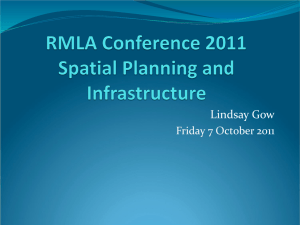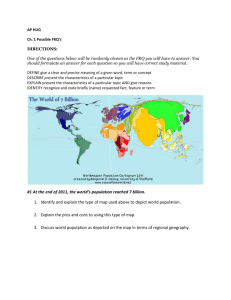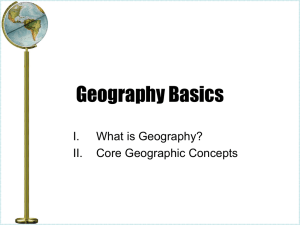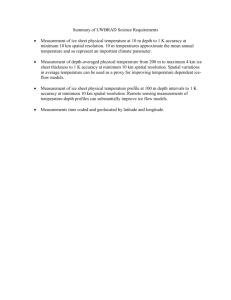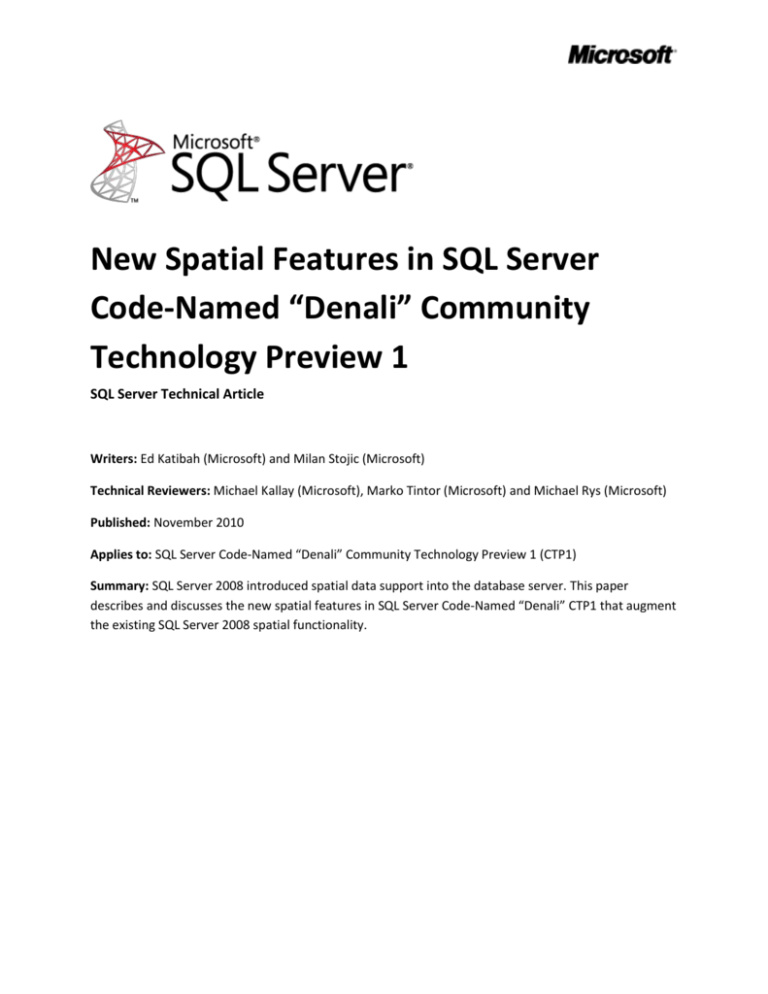
New Spatial Features in SQL Server
Code-Named “Denali” Community
Technology Preview 1
SQL Server Technical Article
Writers: Ed Katibah (Microsoft) and Milan Stojic (Microsoft)
Technical Reviewers: Michael Kallay (Microsoft), Marko Tintor (Microsoft) and Michael Rys (Microsoft)
Published: November 2010
Applies to: SQL Server Code-Named “Denali” Community Technology Preview 1 (CTP1)
Summary: SQL Server 2008 introduced spatial data support into the database server. This paper
describes and discusses the new spatial features in SQL Server Code-Named “Denali” CTP1 that augment
the existing SQL Server 2008 spatial functionality.
Copyright
This is a preliminary document and may be changed substantially prior to final commercial release of the
software described herein.
The information contained in this document represents the current view of Microsoft Corporation on
the issues discussed as of the date of publication. Because Microsoft must respond to changing market
conditions, it should not be interpreted to be a commitment on the part of Microsoft, and Microsoft
cannot guarantee the accuracy of any information presented after the date of publication.
This white paper is for informational purposes only. MICROSOFT MAKES NO WARRANTIES, EXPRESS,
IMPLIED, OR STATUTORY, AS TO THE INFORMATION IN THIS DOCUMENT.
Complying with all applicable copyright laws is the responsibility of the user. Without limiting the rights
under copyright, no part of this document may be reproduced, stored in, or introduced into a retrieval
system, or transmitted in any form or by any means (electronic, mechanical, photocopying, recording, or
otherwise), or for any purpose, without the express written permission of Microsoft Corporation.
Microsoft may have patents, patent applications, trademarks, copyrights, or other intellectual property
rights covering subject matter in this document. Except as expressly provided in any written license
agreement from Microsoft, the furnishing of this document does not give you any license to these
patents, trademarks, copyrights, or other intellectual property.
Unless otherwise noted, the example companies, organizations, products, domain names, e-mail
addresses, logos, people, places, and events depicted herein are fictitious, and no association with any
real company, organization, product, domain name, e-mail address, logo, person, place, or event is
intended or should be inferred.
© 2010 Microsoft Corporation. All rights reserved.
Microsoft, Bing, and SQL Server are trademarks of the Microsoft group of companies.
All other trademarks are property of their respective owners.
2
Contents
Introduction .................................................................................................................................................. 4
Spatial Type Improvements .......................................................................................................................... 4
Circular Arcs: Support for Three New Subtypes ....................................................................................... 4
CircularString......................................................................................................................................... 5
CompoundCurve ................................................................................................................................... 5
CurvePolygon ........................................................................................................................................ 6
Collections of Curved Objects ............................................................................................................... 6
Existing Spatial Methods and Curved Objects ...................................................................................... 7
New Methods for Circular Arcs ............................................................................................................. 8
New and Updated Methods and Aggregates for All Types ....................................................................... 8
Improved Precision ................................................................................................................................. 10
Geography Type Enhancements ............................................................................................................. 10
FullGlobe: Support for Geography Objects Larger Than a Logical Hemisphere ................................. 10
Other Considerations for the geography type .................................................................................... 12
New Methods for the geography Type ............................................................................................... 12
Performance Improvements ....................................................................................................................... 13
Spatial Index Improvements ................................................................................................................... 13
New Spatial Indexes: Geometry Auto Grid and Geography Auto Grid ............................................... 13
SPATIAL_WINDOW_MAX_CELLS: New Spatial Index Hint .................................................................. 14
Compression for Spatial Indexes......................................................................................................... 15
Improved “Create Spatial Index” Build Time for Point Data ............................................................... 16
New Nearest Neighbor Query Plan ......................................................................................................... 16
Other Performance Improvements ........................................................................................................ 16
Other Improvements .................................................................................................................................. 16
Spatial Helper Stored Procedures ........................................................................................................... 17
General Engine Improvements That Affect Spatial Types ...................................................................... 18
Support for Persisted Computed Columns ......................................................................................... 19
Improved CLR UDT Aggregate Performance ....................................................................................... 19
Client-Side Library Changes .................................................................................................................... 19
Conclusion ................................................................................................................................................... 20
3
Introduction
This document covers the new additions in spatial data support, introduced in Microsoft SQL Server
2008, for the SQL Server Code-Named “Denali” Community Technology Preview 1 (CTP1) release. These
new features are organized into the following sections:
“Spatial Type Improvements”
“Performance Improvements”
“Other Spatial Improvements”
In order to fully digest this document the reader should be familiar with spatial data support in
SQL Server 2008.
Note: The Spatial results tab in SQL Server Management Studio has not been updated to handle the new
spatial features present in SQL Server Code-Named “Denali” CTP1. Consequently, the Spatial results tab
has been disabled and is not currently available in SQL Server Management Studio for the SQL Server
Code-Named “Denali” CTP1 build. You can, however, use SQL Server Management Studio from an
existing installation based on SQL Server 2008 or SQL Server 2008 R2 to connect to an instance of SQL
Server Code-Named “Denali.” The Spatial results tab is available for spatial query visualization, in this
case, but it does not support some of the spatial features that are new with SQL Server Code-Named
“Denali” CTP1, such as FullGlobe geography type support and circular arcs. Additionally, note that sideby-side installations of SQL Server Code-Named “Denali” CTP1 are not supported with existing SQL Server
2008 installations.
Spatial Type Improvements
SQL Server Code-Named “Denali” CTP1 introduces several significant enhancements to spatial types,
such as support for new subtypes of circular arcs, new and updated methods and aggregates for all
subtypes, improved precision, and updates to the geography type.
Circular Arcs: Support for Three New Subtypes
Circular arcs are new to CTP1 and are based on the ISO SQL/MM, Part 3: Spatial standard. Circular arcs
can be defined by themselves or they can be combined with line segments. Circular arcs can also be the
basis for a new type of polygon that contains one or more curve components. For example, parallels on
the globe (line of latitude) can be expressed as geography circular arcs. Sample circular arcs are
illustrated here.
4
Circular arcs are supported by geometry and geography and can be defined using Well-known Text
(WKT), Well-known Binary (WKB), and Geography Markup Language (GML) in SQL Server Code-Named
“Denali.”
CircularString
Circular strings are the basic curve subtype, corresponding to a LineString for linear data. Three points
are used to define a segment with the start (first point) and end (third point) points and another point
(second point) anywhere along the circular arc. Circular strings can be linked together where the last
point of the previous curve becomes the first point of the next curve. Valid circular strings will always
have an odd number of points, three or greater.
DECLARE @g GEOGRAPHY;
SET @g = GEOGRAPHY::STGeomFromText('
CIRCULARSTRING(0 -23.43778, 0 0, 0 23.43778)
)',4326);
CompoundCurve
Compound curves enable you to define new curves that can be composed of circular strings only, or
circular strings and linear strings. The end point of every component must be identical to the starting
point of the next component.
Here is an example of a CompoundCurve made up of circular strings only.
DECLARE @g GEOGRAPHY;
SET @g = GEOGRAPHY::STGeomFromText('
COMPOUNDCURVE(
CIRCULARSTRING(0 -23.43778, 0 0, 0 23.43778),
CIRCULARSTRING(0 23.43778, -45 23.43778, -90 23.43778)
CIRCULARSTRING(-90 23.43778, -90 0, -90 -23.43778),
CIRCULARSTRING(-90 -23.43778, -45 -23.43778, 0 -23.43778)
)',4326);
Here is an example of a CompoundCurve made up of circular strings and linear strings. Note that linear
strings do not contain a keyword.
DECLARE @g GEOGRAPHY;
SET @g = GEOGRAPHY::STGeomFromText('
COMPOUNDCURVE(
(0 -23.43778, 0 23.43778),
--Linear Segment*
CIRCULARSTRING(0 23.43778, -45 23.43778, -90 23.43778),
(-90 23.43778, -90 -23.43778), --Linear Segment*
CIRCULARSTRING(-90 -23.43778, -45 -23.43778, 0 -23.43778)
)',4326);
*Note: You must remove the SQL comments (in green) from this example before it will execute correctly
in Transact-SQL.
5
CurvePolygon
Curve polygons are similar to polygons, having at least one ring and zero or more holes (inner rings).
Curve polygons are composed of linear strings, circular strings, and/or compound curves. Within a given
ring, the first point as defined in a curve polygon component must be identical to the last point in a
curve polygon component, just like standard polygon rings.
Here is an example of a CurvePolygon made up of compound curves, themselves made up of circular
strings and linear strings.
DECLARE @g GEOGRAPHY;
SET @g = GEOGRAPHY::STGeomFromText('
CURVEPOLYGON(
COMPOUNDCURVE(
(0 -23.43778, 0 23.43778),
CIRCULARSTRING(0 23.43778, -45 23.43778, -90 23.43778),
(-90 23.43778, -90 -23.43778),
CIRCULARSTRING(-90 -23.43778, -45 -23.43778, 0 -23.43778)
)
)',4326);
Collections of Curved Objects
In order to create a collection of curved objects with objects without curves, a geometry collection must
be used.
DECLARE @g GEOGRAPHY
SET @g = GEOGRAPHY::STGeomFromText('
GEOMETRYCOLLECTION(
COMPOUNDCURVE(
CIRCULARSTRING(0 23.43778, -45 23.43778, -90 23.43778),
(-90 23.43778, -90 -23.43778)
),
COMPOUNDCURVE(
CIRCULARSTRING(-90 -23.43778, -45 -23.43778, 0 -23.43778),
(0 -23.43778, 0 23.43778)
)
)',4326);
The following illustration shows the difference between circular arcs and linear strings for the same set
of coordinates.
6
CIRCULARSTRING(0 50, 90 50, 180 50, 270 50, 0 50) -- RED LINE
and
LINESTRING (0 50, 90 50, 180 50, 270 50, 0 50) –- YELLOW LINE
Note: The circular string defined in the previous example represents a circle on the globe, defined by five
points in which the first and last coordinates are the same. You can create this feature as a curve polygon
as follows.
DECLARE @g GEOGRAPHY
SET @g = GEOGRAPHY::STGeomFromText('
CURVEPOLYGON(
CIRCULARSTRING(0 50, 90 50, 180 50, 270 50, 0 50)
)',4326);
Existing Spatial Methods and Curved Objects
All existing methods work on circular objects (STIntersects is illustrated here).
7
New Methods for Circular Arcs
BufferWithCurves() uses circular arcs to construct buffered object with greatly reduced number
of points compared to STBuffer().
STNumCurves() and STCurveN() are used for iteration through the list of the edges.
STCurveToLine() and CurveToLineWithTolerance() are used for approximating circular
arcs with line segments within default and user specific tolerance.
Note: STCurveToLine and CurveToLineWithTolerance can be used to convert both
LineStrings/MultiLineStrings and Polygons/MultiPolygons that have circular arc components to linear
representations of the same dimensionality. This can use useful for:
Spatial object representation in visualization programs
Backward compatibility with earlier versions of SQL Server that have spatial data support
New and Updated Methods and Aggregates for Both Spatial Types
ShortestLineTo() returns a LineString that represents the shortest distance between two objects.
The resulting LineString does not have to touch either parent object on a shape-defining vertex point.
The following aggregates are now available. They are exposed as static methods on geography and
geometry types:
8
UnionAggregate
EnvelopeAggregate
CollectionAggregate
ConvexHullAggregate
For example, the following SELECT statement acts on and returns the data shown in the illustration.
SELECT GEOGRAPHY::UnionAggregate(geog) FROM Regions;
Note: The new aggregates are exposed in SQL Server only and are not exposed in the underlying spatial
library.
STLength() has been updated an now works on both valid and invalid LineStrings. This was done for
LineStrings because the MakeValid method can remove overlapping parts. Typically a LineString is
invalid due to overlapping segments, which may be caused by anomalies such as inaccurate GPS traces.
Note: STLength() does not remove overlapping/invalid segments. Additionally, STLength() includes
overlapping and invalid segments in the length value it returns.
MinDbCompatibilityLevel() is a new method is used for backward compatibility. It indicates
whether spatial objects can be recognized by SQL Server 2008 and SQL Server 2008 R2.
DECLARE @C GEOMETRY
SET @C = GEOMETRY::Parse('CIRCULARSTRING(0 50, 90 50, 180 50)')
SELECT @C.MinDbCompatibilityLevel()
--Result: 110
DECLARE @L GEOMETRY
SET @L = GEOMETRY::Parse('LINESTRING (0 50, 90 50, 180 50)')
SELECT @L.MinDbCompatibilityLevel()
--Result: 100
Note: You can set the compatibility level of the database with the following Transact-SQL statement.
--Set database compatibility level to SQL Server Code-Named "Denali"
ALTER DATABASE database
SET COMPATIBILITY_LEVEL = 110;
--Set database compatibility level to SQL Server 2008
ALTER DATABASE database
SET COMPATIBILITY_LEVEL = 100;
9
Improved Precision
All constructions and relations are now done with 48 bits of precision, compared to 27 bits used in
SQL Server 2008 and SQL Server 2008 R2. This can reduce the error caused by rounding of floating point
coordinates for original vertex points by the internal computation.
For example, consider the following coordinate, which was processed using the STUnion() method in
SQL Server 2008 but which was not involved in the resulting geometry.
Original Vertex Coordinate
New Vertex Coordinate After Computation
82.339026 29.661245
82.339025999885052 29.662144999951124
In SQL Server Code-Named “Denali,” the greater numerical precision assists in the preservation of
original coordinates of input points, in most cases. Here is the result of the same STUnion() method in
SQL Server Code-Named “Denali,” shown earlier.
Original Vertex Coordinate
New Vertex Coordinate After Computation
82.339026 29.661245
82.339026 29.662145
Geography Type Enhancements
FullGlobe: Support for Geography Objects Larger Than a Logical Hemisphere
The SQL Server Code-Named “Denali” Spatial Library supports objects that are larger than a logical
hemisphere. Restricted to slightly less than a logical hemisphere in SQL Server 2008, spatial objects in
SQL Server Code-Named “Denali” can now be as big as entire globe. A new type of object, called
FULLGLOBE, can be constructed or received as a result of an operation. You can also construct objects
that are “small holes” (see the following picture), because the interior for geography objects is defined
by the orientation of its rings. There is no difference between exterior and interior rings in the
geography data type.
UNION
yields
The first image shows an example of a “small hole” in a FullGlobe object, the second image shows a
regular polygon, and the third image shows the union of the two, yielding a spatial object that covers
the Earth with three small holes.
Here is a simple example that constructs a new FullGlobe object and executes a method on that object.
10
DECLARE @g GEOGRAPHY = GEOGRAPHY::STGeomFromText('FULLGLOBE',4326);
SELECT @g.STArea()-- calculate the area of the WGS84 ellipsoid
--Result: 510,065,621,710,996 meters squared
Vertex order is critical for the geography type. In SQL Server 2008 and SQL Server 2008 R2, if you enter
an “incorrect” coordinate order for a geography polygon, you receive an error:
The specified input does not represent a valid geography instance because it exceeds a
single hemisphere. Each geography instance must fit inside a single hemisphere. A
common reason for this error is that a polygon has the wrong ring orientation.
For the SQL Server geography data type, ring order defined by the left-foot rule. The left-foot rule
defines the interior region of the polygon (when you “walk” the boundary of a polygon, your left foot is
always inside). Traditional outer ring/inner ring (hole) relationships can be modeled on the closed
surface of the globe by using this definition.
Note: The term “left-foot rule” is used in deference to the term “left-hand rule,” which is already in use
by physicists and mathematicians to describe phenomena other than polygon ring order.
The following examples demonstrate how the geography type deals with large (greater than a logical
hemisphere) objects.
Here is an example of a small (less than a logical hemisphere) polygon.
DECLARE @R GEOGRAPHY;
SET @R = GEOGRAPHY::Parse('Polygon((-10 -10, 10 -10, 10 10, -10 10,
-10 -10))');
SELECT @R;
The resulting object can be visualized as follows.
11
The following Transact-SQL changes the coordinate order of the polygon ring to the opposite direction
of the previous example.
DECLARE @R GEOGRAPHY;
SET @R = GEOGRAPHY::Parse('Polygon((-10 -10, -10 10, 10 10, 10 -10,
-10 -10))');
SELECT @R;
The resulting object is now the “rest of the globe.”
Other Considerations for the geography type
There are several other considerations which need to be taken into account with the FullGlobe
enhancements to the geography type:
FullGlobe cannot be a member of a GeometryCollection
WKT, WKB and GML (and its schema) now support FullGlobe objects
Antipodal edges are not allowed (for example, Linestring(0 90, 0 -90) is considered antipodal
while LineString(0 90, 0 0, 0 -90) is not)
There are now two types of arcs in geography: great circle arcs defined with two points and
small circle arcs defined with three points
Degenerate arcs will be treated as great circle arcs between the start and end points for the
geography type (for the geometry type such arcs will be treated as straight edges)
EnvelopeAngle() will return 180 for objects larger than a logical hemisphere and < 90 for smaller
than a logical hemisphere objects
New Methods for the geography Type
The geography type now allows invalid objects to be inserted into a table. The following new methods
deal with such objects.
STIsValid() and MakeValid() allow invalid geography objects can be detected and corrected the
same way as for the geometry type.
12
Geography polygons can now be accommodated without regard to ring orientation. This can lead to
unintended behavior. The following new method allows such polygons to be corrected.
ReorientObject()can be used to reorient polygon rings for cases where they are constructed with
the wrong orientation. LineStrings, curves and points will not be touched.
Here is an example.
DECLARE @R GEOGRAPHY = GEOGRAPHY::Parse('Polygon((-10 -10, -10 10, 10 10,
10 -10, -10 -10))');
SELECT @R.ReorientObject().STAsText();
--Result: POLYGON ((10 10, -10 10, -10 -10, 10 -10, 10 10))
STWithin(), STContains(), STOverlaps(), and STConvexHull() methods have been
added for the geography type, previously available only for the geometry type. With the exception of
STConvexHull(), these new methods are supported by spatial indexes.
Performance Improvements
SQL Server Code-Named “Denali” CTP1 includes features and enhancements that improve performance.
These include new spatial indexes, a spatial index hint, compression, improved index build time, and a
new query plan.
Spatial Index Improvements
New spatial indexes provide further levels of tuning, and a new hint helps you fine-tune query
performance.
New Spatial Indexes: Geometry Auto Grid and Geography Auto Grid
A new auto grid spatial index is available for both spatial types (geometry_auto_grid and
geography_auto_grid). The GRIDS parameter is no longer valid or needed when this index type is used.
The new auto grid actually uses a different strategy to pick the right tradeoff between performance and
efficiency. It uses eight levels (instead of four) for better approximation of objects of various sizes. The
older style spatial index with four user-specified levels is still supported and is now referred to as a
“manual grid” spatial index.
Here are some examples that use the new auto grid for the geography data type.
CREATE SPATIAL INDEX idxGeog
ON table(column)
USING GEOGRAPHY_AUTO_GRID;
or
13
CREATE SPATIAL INDEX idxGeog
ON table(column)
USING GEOGRAPHY_AUTO_GRID
WITH (CELLS_PER_OBJECT = 32);
If an index type is not specified in the CREATE SPATIAL INDEX DDL, the appropriate auto grid for the
specified spatial column data type is used by default. In the following example, if the spatial column data
type is geography, the GEOGRAPHY_AUTO_GRID is used by default.
CREATE SPATIAL INDEX idxGeog
ON table(column);
The following figure illustrates spatial object approximation with 64, 128, and 256 cells_per_object,
respectively, on the new eight-level auto grid. New auto grid spatial indexes have better continuous
coverage and higher precision.
Spatial Object
Partially
contained
cells
Fully
contained
cells
The default number of cells per object for the new auto grid is 8 for geometry and 12 for geography. For
original GEOMETRY_GRID and GEOGRAPHY_GRID indexes, the default for CELLS_PER_OBJECT remains
the same as previous at 16.
Note: The CELLS_PER_OBJECT parameter is not used for point objects. It is used for all other objects,
including multipoint objects.
SPATIAL_WINDOW_MAX_CELLS: New Spatial Index Hint
This new spatial hint is critical for fine-tuning query performance using a spatial index. Dense spatial
data often requires a higher SPATIAL_WINDOW_MAX_CELLS, whereas sparse spatial data often
demands a lower SPATIAL_WINDOW_MAX_CELLS for optimum performance.
14
This hint can be used as follows.
SELECT *
FROM table t with(SPATIAL_WINDOW_MAX_CELLS=1024)
WHERE t.geom.STIntersects(@window)=1;
The default value is 512 for geometry and 768 for geography. Higher values make the spatial index more
efficient, but the primary filter is slower. Lower values make the primary filter faster, but more time is
spent in the secondary filter due to potentially poorer index efficiency, with the optimum somewhere in
between. For example, in the following illustration, 256 cells is the optimum query window.
This chart shows query execution time (in milliseconds) compared to the old configurations (HHHH,
HHMM, and MMMM in the three left-hand columns). Total times are combined primary filter times and
secondary filter times. Making spatial indexes more precise improves overall performance until the
tipping point is reached.
Note: For SQL Server 2008, this parameter was always set to 1024 and was not modifiable.
Compression for Spatial Indexes
Compression can be enabled on spatial indexes with Transact-SQL DDL.
CREATE SPATIAL INDEX idxGeom
ON table(column)
USING GEOGRAPHY_GRID
WITH (
DATA_COMPRESSION = page|row
);
15
On the basis of internal tests, spatial indexes with compression are 40-50 percent smaller, with a 5-10
percent performance overhead.
Improved “Create Spatial Index” Build Time for Point Data
Spatial index build time for point data can be as much as roughly four to five times faster than it is under
similar conditions in SQL Server 2008.
New Nearest Neighbor Query Plan
A nearest neighbor query plan can be expressed as follows (the query elements highlighted in red are
required for making the query optimizer process queries using a nearest neighbor query plan).
SELECT TOP(5) *
FROM Restaurants r
WHERE r.type = ‘Italian’
AND r.position.STDistance(@me) IS NOT NULL
ORDER BY r.position.STDistance(@me);
It can also be expressed with limited maximum distance.
SELECT TOP(5) *
FROM Restaurants r
WHERE r.type = ‘Italian’
AND r.position.STDistance(@me) < @max_range
ORDER BY r.position.STDistance(@me);
This enhancement uses a spatial index to filter out rows and speed up query execution. With a spatial
index, nearest neighbor execution time is up to two orders of magnitude faster (10 to 30 times) than a
counterpart query in SQL Server 2008.
Other Performance Improvements
The methods STIntersects(), STWithin(), STContains(), and STOverlaps() are now
optimized when at least one of the operands is a point.
STDistance() performance between two points has been optimized.
STBuffer() has been optimized and improved for all cases. It’s faster and has lower memory
footprint, especially for large and complex objects.
Other Improvements
SQL Server Code-Named “Denali” also introduces other improvements to the way spatial data is
handled. These improvements include two new stored procedures, general engine improvements, and
client-side library changes.
16
Spatial Helper Stored Procedures
Two new helper stored procedures are available:
sp_help_spatial_geography_histogram
sp_help_spatial_geometry_histogram
These routines can be used to evaluate the distribution of spatial data within a table over a given spatial
column.
For example, the following query uses the sp_help_spatial_geography_histogram stored procedure to
return information about the distribution of spatial data in the Mexico table for the geography column.
EXEC sp_help_spatial_geography_histogram Mexico,geography,1000,100
Arguments: <table name>, <spatial column>, <cell size>, <sample %>
Here is sample output from the previous query.
The output can be used for investigating spatial index efficiency or analyzing spatial data in general. The
histograms can be also shown in the SQL Server Management Studio Spatial results tab.
17
The following is an SQL Server Management Studio-based illustration of the same display, showing
greater detail (from the upper left-hand corner).
With some additional programming, data from these stored procedures can be used for external
visualization, shown over Bing Maps.
General Engine Improvements That Affect Spatial Types
SQL Server Code-Named “Denali” CTP1 includes support for persisted computed columns and improved
CLR UDT performance.
18
Support for Persisted Computed Columns
UDTs and spatial types can now be persisted in computed columns as shown in the following example.
CREATE TABLE location (
id int primary key,
x float(max),
y float(max),
range float(max),
geom as
geometry::Point(x, y, 0)
.STBuffer(range) PERSISTED);
Improved CLR UDT Aggregate Performance
CLR UDT aggregates in general (and by inference, new spatial aggregates) are improved and have much
better performance. They are now 5 to 20 times faster compared to SQL Server 2008.
Client-Side Library Changes
New sink interfaces, IGeometrySink110 and IGeographySink110, are available, and you should plan to
use them in your future programming. They must be used for the following types of objects, which are
incompatible with SQL Server 2008:
Objects bigger than a logical hemisphere
Objects with circular arcs
However, the old sinks will continue to work for SQL Server 2008 compatible objects.
Geometry and Geography builders (SqlGeometryBuilder and SqlGeographyBuilder) now support circular
arc constructions.
A new method, Deserialize, has been added on the client library to both types. This method simplifies
deserialization. The following code shows how to use it to deserialize SqlBytes.
using (SqlConnection con = new SqlConnection("..."))
{
con.Open();
SqlCommand cmd = new SqlCommand("...", con);
SqlDataReader reader = cmd.ExecuteReader();
while (reader.Read())
{
SqlGeography g = SqlGeography.Deserialize(reader.GetSqlBytes(0));
Console.WriteLine(g)
}
}
19
Conclusion
The new spatial features in SQL Server Code-Named “Denali” CTP1 represent a significant milestone in
the evolution of SQL Server spatial data support. The ability to support full globe spatial objects and
circular arcs on the ellipsoid are industry firsts for relational database systems. The geography data type
has achieved parity relative to the function and variety of methods that support the geometry data
type. Overall performance, from spatial indexes to methods, has been significantly increased. These and
other improvements to spatial promise a significant step forward in spatial prowess of the next
generation of SQL Server.
20

